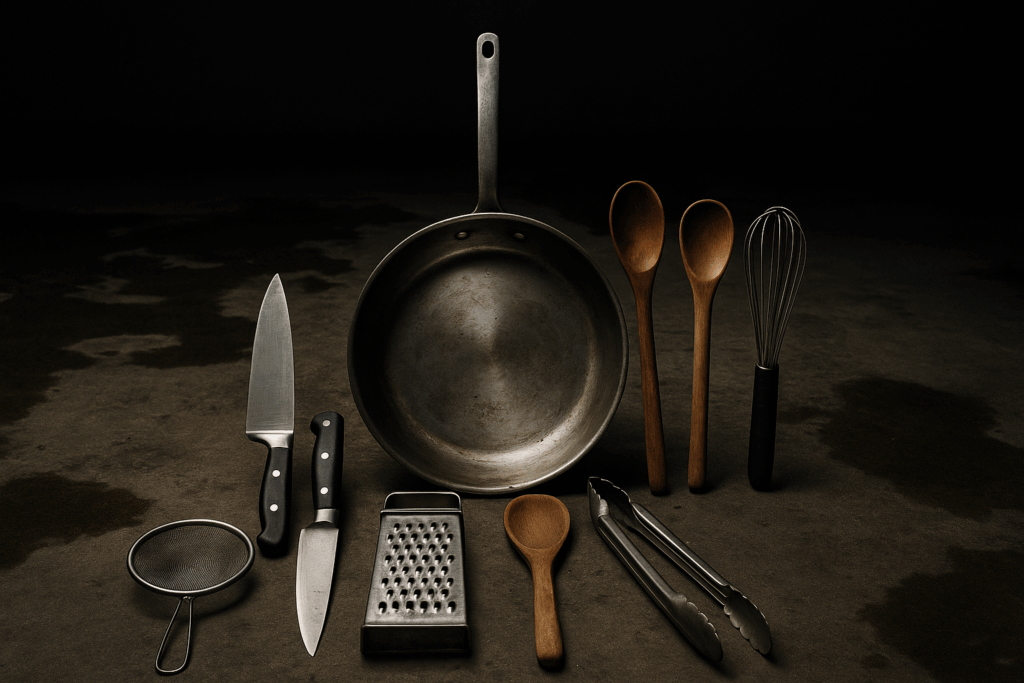Start With the Basics
Before you dive into the world of air fryers and electric tagine pots, lock down the fundamentals. Any solid kitchen setup needs tools that work consistently, clean easily, and serve more than one purpose. That means skipping single-use gadgets and focusing on gear that earns its shelf space.
Start with a good chef’s knife—sharp, balanced, and reliable. It’s the workhorse for everything from chopping onions to carving chicken. Next up is a solid cutting board (bonus if it’s double-sided), a set of nesting mixing bowls, and a handful of wooden spoons or silicone spatulas. A heavy-bottomed skillet, a medium saucepan, and a large pot will cover 90% of your stovetop needs.
Don’t overthink the rest. You don’t need three sets of measuring cups or a spiralizer that’ll sit untouched. Stick with things that do double duty—like a Dutch oven that bakes bread and slow-cooks stew, or a sheet pan that roasts vegetables and catches drips under pies.
Less is more here. A lean, functional kitchen setup gets you cooking faster and cleaning less. That’s the goal.
Know Your Cooking Style
Before you start filling drawers and cabinets with gear, ask a simple question: how often are you actually in the kitchen? Are you the weeknight warrior—cooking fast, functional meals after work? Or the weekend chef—blocking off Sunday to tackle that slow braise or four-hour sourdough?
Your tools should match your tempo. If you’re cooking Monday through Thursday, invest in quality stovetop basics. Think: a dependable nonstick skillet, a solid chef’s knife, and a saucepan that won’t warp under daily use. A good cutting board and a few silicone spatulas might be all you need to make dinner without dreading cleanup.
Baking on weekends or diving into multi-step recipes? That’s a different cart. You’ll want measuring tools that are accurate and sturdy, sheet pans that don’t bend under heat, and maybe a stand mixer—if you’re serious. Oven thermometers, cooling racks, and accurate timers start to matter more when precision counts.
The trick is not to overbuy but to outfit to your real routine. If your blender only comes out once a month, that $300 model probably isn’t earning its keep. But if you’re meal prepping weekly for a family of four, don’t skimp on a Dutch oven or a good rice cooker.
Your gear should serve you—not the other way around.
Space and Storage: What Fits, Stays
Kitchen size isn’t just a layout detail—it can make or break how you cook. A cluttered, cramped kitchen slows you down and kills your flow. On the flip side, smart space = smoother cooking. Whether you’re working in a studio apartment or just trying to get more out of a galley kitchen, the goal is simple: make every inch work.
Start with your tools. Think collapsible measuring cups, stackable mixing bowls, nesting pots. These compact designs don’t cut corners on function. They just know when to get out of the way. Quality still matters—choose gear that feels solid and cleans up easy, even if it folds flat or hides in a drawer.
Next, go vertical. Wall-mounted racks, magnetic knife strips, and overhead rails give you room without eating counter space. Modular shelving can turn dead zones into extra storage. Even under-cabinet hooks or rolling carts can make a big difference. The trick is to keep it flexible—what works in your space should change as your routines do.
The less clutter, the better the kitchen. Be ruthless with what earns its place. Not everything needs to be within arm’s reach—just the things you use often, and they’d better be easy to grab.
Quality over Quantity
Investing in your kitchen tools is about more than just convenience—it’s about reliability, safety, and performance. While it might seem budget-friendly to go for the cheapest options, that decision can cost you more in the long run.
Why Buying Cheap Often Costs More
Low-cost kitchen gear often comes with hidden downsides:
- Wears out quickly: Handles break, non-stick coatings peel, and edges dull faster.
- Inconsistent performance: Cheap pans heat unevenly, causing poor cooking results.
- Hidden costs: Replacing inexpensive tools frequently often adds up to more than a single, quality purchase.
Think of essential kitchen tools as investments—they should stand up to daily use and last years, not months.
Key Materials That Matter
When selecting kitchen tools, materials make a big difference in both performance and safety. Look for:
- Stainless steel: Durable, rust-resistant, and great for pots, pans, and utensils.
- Cast iron: Ideal for high-heat cooking and excellent at retaining heat. Bonus: it gets better with age if seasoned properly.
- BPA-free plastics: Safe for food contact and durable, especially for prep tools like measuring cups and mixing bowls.
Opting for these materials ensures that your gear stays safer and stronger for longer.
When to Splurge—and When Not To
You don’t need top-of-the-line versions of everything. Be selective about where you spend:
Worth the investment:
- Chef’s knife
- Cutting board
- Everyday cookware (like a heavy-bottomed pan)
Save or skip:
- Specialty gadgets you’ll rarely use
- Trendy accessories that don’t hold up over time
- Decorative tools that don’t add functional value
The key is to prioritize tools you’ll use often and depend on. These are the items that should combine durability, performance, and comfort.
In the long run, choosing quality saves you both frustration and money.
Budget Smart, Not Sparse
You don’t need a $1,200 mixer to cook a solid meal—or even a great one. Small, affordable upgrades can make a huge difference without draining your wallet. A good serrated knife, a durable non-stick pan, or a reliable digital thermometer all pack more day-to-day impact than flashy gadgets.
The trick is building up your collection based on real use. Instead of buying a 20-piece cookware set you’ll barely touch, focus on adding gear as your skills—and recipes—expand. Start with a skillet and a chef’s knife. Add a Dutch oven once you’re batch-cooking or braising. Keep your eye on what you actually reach for.
Secondhand tools are also a goldmine. Cast iron skillets, stainless cookware, and even high-end blenders can often be found at thrift stores, garage sales, or online marketplaces in perfectly usable condition. As long as you check for damage or wear, pre-owned doesn’t mean second-rate. It means smart.
Buy with purpose, upgrade with experience—and your kitchen will grow with you.
Specialized Tools vs. Everyday Workhorses
There’s a time and place for niche tools—just make sure the timing is right. If you’re the kind of person who makes fresh pasta every Sunday, then, yes, a pasta maker earns its shelf space. Same goes for that sushi mat or tamale steamer—if it’s something you’ll use often enough to justify the footprint, go for it. But if it’s a once-a-year curiosity, skip it or borrow one when needed.
That said, most of your kit should lean on the side of versatility. Here are five tools that work hard across recipes and won’t sit idle:
- Chef’s Knife – The true MVP. It handles chopping, slicing, trimming—you name it.
- Cast Iron Skillet – From stovetop to oven, it sears, bakes, and lasts forever.
- Cutting Board (Large and Durable) – More prep space equals less mess. Bamboo or plastic works.
- High-Quality Tongs – Grip, flip, serve. Feels small, makes a big difference.
- Measuring Cups and Spoons – Accuracy matters. Especially in baking, but also in keeping portions in check.
The goal isn’t to own every gadget. It’s to equip yourself with tools that align with how you actually cook. Lay off single-purpose clutter—ice cream makers, avocado slicers, countertop pizza ovens—unless they’re consistent players in your kitchen life. Save your space, your budget, and your sanity.
Health and Safety Considerations
Cooking gear isn’t just about getting dinner on the table—it’s also about what you’re putting into your body over time. More people are waking up to the fact that certain materials can leach chemicals into food, especially under high heat. Non-toxic cookware like ceramic, stainless steel, and cast iron offers peace of mind you won’t find in cheap nonstick coated pans. Look for labels that call out PFOA- and PTFE-free coatings if you’re going the nonstick route.
Cleaning matters, too. If a piece of cookware requires its own instruction manual to wash, chances are it’s going to become a dust collector. Dishwasher-safe tools and seamless, easy-to-scrub surfaces save time—and reduce the chance of bacteria hanging around. Bonus: fewer crevices means fewer excuses to skip the cleanup.
The right tools also nudge you toward better habits. A sharp chef’s knife makes it easier to prep fresh produce. A steamer basket suddenly makes veggies less of a chore. Having quality, safe, and easy-to-maintain gear lowers friction, which makes healthy cooking feel like less of a grind.
Want to dive deeper? Check out these free nutrition and diet resources.
Parting Advice: Start Simple, Upgrade with Intention
You don’t need to kit out your kitchen like a cooking show set on day one. Most good cooking starts with a knife, a pan, and the willingness to burn a few things. Progress comes with practice—and so should your gear. Start with what you’ll actually use this week, not what someone on TikTok said was life-changing.
The more you cook, the clearer your habits get. Maybe you bake twice a month but sauté every night. That tells you where to spend money (skip the stand mixer, get a better non-stick). Let your rhythms steer your purchases.
Also, remember: influencers don’t live in your kitchen. They’re often recommending gear they were paid to pitch—and owning ten cutting boards doesn’t make your food taste better. Tune into your own needs. Upgrade when it makes a real difference, not just because it’s trending.

 Thalira Tornhanna, the visionary founder of Food Smart Base, established the platform with a passion for transforming the way people engage with food. Guided by her dedication to health, innovation, and culinary education, she created a resource that not only delivers industry news and nutritional advice but also inspires better cooking practices and highlights emerging food trends. Through her leadership, Food Smart Base has become a trusted hub where readers can discover practical knowledge and fresh ideas that empower them to make smarter choices in their daily lives.
Thalira Tornhanna, the visionary founder of Food Smart Base, established the platform with a passion for transforming the way people engage with food. Guided by her dedication to health, innovation, and culinary education, she created a resource that not only delivers industry news and nutritional advice but also inspires better cooking practices and highlights emerging food trends. Through her leadership, Food Smart Base has become a trusted hub where readers can discover practical knowledge and fresh ideas that empower them to make smarter choices in their daily lives.